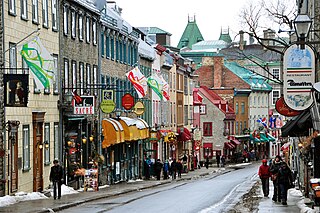
Quebec City, officially known as Québec, is the capital city of the Canadian province of Quebec. As of July 2021, the city had a population of 549,459, and the metropolitan area had a population of 839,311. It is the twelfth-largest city and the seventh-largest metropolitan area in Canada. It is also the second-largest city in the province, after Montreal. It has a humid continental climate with warm summers coupled with cold and snowy winters.
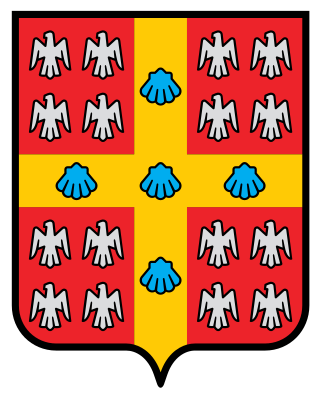
Université Laval is a public research university in Quebec City, Quebec, Canada. The university traces its roots to the Séminaire de Québec, founded by François de Montmorency-Laval in 1663, making it the oldest institution of higher education in Canada and the first North American institution to offer higher education in French. The university, which was founded in Old Québec, moved to a new campus in the 1950s in the suburban borough of Sainte-Foy–Sillery–Cap-Rouge. It is ranked among the top 10 Canadian universities in research funding and holds four Canada Excellence Research Chairs.
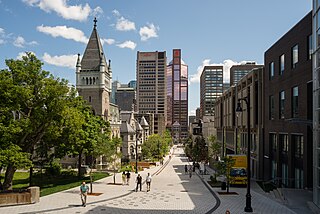
The architecture of Montreal, Quebec, Canada is characterized by the juxtaposition of the old and the new and a wide variety of architectural styles, the legacy of two successive colonizations by the French, the British, and the close presence of modern architecture to the south. Much like Quebec City, the city of Montreal had fortifications, but they were destroyed between 1804 and 1817.
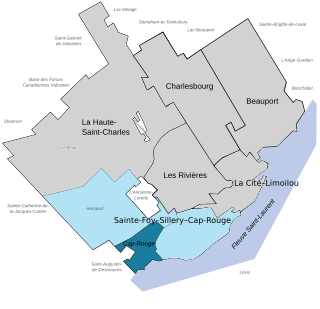
Cap-Rouge is a former city in central Quebec, Canada, since 2002 within the borough Sainte-Foy–Sillery–Cap-Rouge in Quebec City. The site of the first attempted permanent French settlement in North America, Charlesbourg-Royal, is located at the confluence of the Rivière du Cap Rouge and the Saint Lawrence River. Its population was 13,153 as of the Canada 2011 Census.
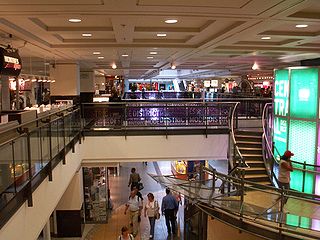
RÉSO, commonly referred to as the Underground City, is the name applied to a series of interconnected office towers, hotels, shopping centres, residential and commercial complexes, convention halls, universities and performing arts venues that form the heart of Montreal's central business district, colloquially referred to as Downtown Montreal. The name refers to the underground connections between the buildings that compose the network, in addition to the network's complete integration with the city's entirely underground rapid transit system, the Montreal Metro. Moreover, the first iteration of the Underground City was developed out of the open pit at the southern entrance to the Mount Royal Tunnel, where Place Ville Marie and Central Station stand today.

Place Ville Marie is a large office and shopping complex skyscraper in Downtown Montreal, Quebec, Canada, comprising four office buildings and an underground shopping plaza. The main building, 1 Place Ville Marie, was built in the International style in 1962 as the headquarters for the Royal Bank of Canada. While RBC's corporate headquarters and the majority of its management operations have been based in Toronto's Royal Bank Plaza since 1976, Place Ville Marie remains RBC's head office, a distinct title from its corporate headquarters. It is a 188 m (617 ft), 47-storey, cruciform office tower. The complex is a nexus for Montreal's Underground City, the world's busiest, with indoor access to over 1,600 businesses, numerous subway stations, a suburban transportation terminal, and tunnels extending throughout downtown. A counter-clockwise rotating beacon on the rooftop lights up at night, illuminating the surrounding sky with up to four white horizontal beams that can be seen as far as 50 kilometres (31 mi) away. This beacon is not considered as a NAVAID for aviation purposes.

Ville-Marie is the name of a borough (arrondissement) in the centre of Montreal, Quebec. The borough is named after Fort Ville-Marie, the French settlement that would later become Montreal, which was located within the present-day borough. Old Montreal is a National Historic Site of Canada.

Le Sud-Ouest is a borough (arrondissement) of the city of Montreal, Quebec, Canada.
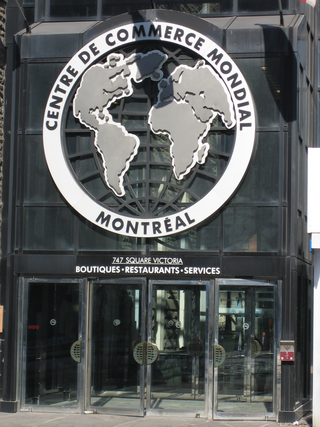
The Quartier international de Montréal (QIM) or Montreal's International District is a district of the Ville-Marie borough in the city's downtown core of Montreal, Quebec, Canada. It is roughly bordered by René-Levesque Boulevard to the north, Notre-Dame Street to the south, De Bleury/Saint-Pierre Street to the east and Robert-Bourassa Boulevard to the west. The Palais des congrès building lying just east of the district is also usually comprised in it. Constructed dispersedly between 1965 and 1985 in place of older colonial housing blocks, the district underwent major urban renewal as a central business district in 2000–2003.

The five-story Montreal City Hall is the seat of local government in Montreal, Quebec, Canada. It was designed by architects Henri-Maurice Perrault and Alexander Cowper Hutchison, and built between 1872 and 1878 in the Second Empire style. It is located in Old Montreal, between Place Jacques-Cartier and the Champ de Mars, at 275 Notre-Dame Street East. The closest Metro station is Champ-de-Mars, on the Orange Line.

Old Quebec is a historic neighbourhood of Quebec City, Quebec, Canada. Comprising the Upper Town and Lower Town, the area is a UNESCO World Heritage Site. Administratively, Old Quebec is part of the Vieux-Québec–Cap-Blanc–colline Parlementaire district in the borough of La Cité-Limoilou.

The Seminary of Quebec is a Catholic community of diocesan priests in Quebec City founded by Bishop François de Laval, the first bishop of New France in 1663.

The urban agglomeration of Longueuil was created on January 1, 2006 as a result of the de-amalgamation process brought upon by the Charest government. It encompasses all the boroughs that were merged into the previous city of Longueuil and still retains the same area as that mega-city.

Notre-Dame Street is a historic east–west street located in Montreal, Quebec, Canada. It runs parallel to the Saint Lawrence River, from Lachine to the eastern tip of the island in Pointe-aux-Trembles, then continuing off the island into the Lanaudière region.
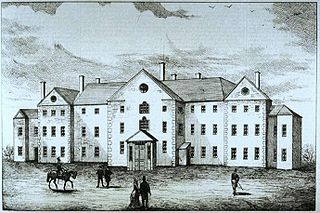
The Chateau St. Louis in Quebec City was the official residence of the French Governor of New France and later the British Governor of Quebec, the Governor-General of British North America, and the Lieutenant-Governor of Lower Canada.

The City Hall of Quebec City is the seat of local government in Quebec City, Quebec, Canada. It was inaugurated on September 15, 1896 in the Old Quebec neighbourhood. The building slopes downward as it was built on a hill and was once home to the Jesuit College from the 1730s to 1878.

Vieux-Québec–Cap-Blanc–Colline Parlementaire is one of the 35 districts of the City of Quebec, and one of six that are located in the borough of La Cité-Limoilou. The district is the most visited and toured location in the city. It is in this partly fortified area where the Château Frontenac is found, with its large terrace overlooking the city of Lévis, across the Saint Lawrence River. A large concentration of cafes, tourist shops, restaurants, hotels and inns are situated in the district. In its most recent census count in 2016, Statistics Canada reported that the district had a population of 5,770 residents, whom comprise 1.1% of the city's total population.

The Sillery Heritage Site is an area containing historic residences and institutional properties located in the Sainte-Foy–Sillery–Cap-Rouge borough of Quebec City, Quebec, Canada. It was the first of 13 declared heritage sites of the Province of Quebec, and is among the four of which are located in Quebec City. Having been called the "cradle of the French Canadian nation," the heritage site includes approximately 350 buildings along 3.5 kilometres of the Saint Lawrence River shoreline. The Sillery Heritage Site includes buildings constructed during every major period of Quebec's history, dating back to the time of New France.










































